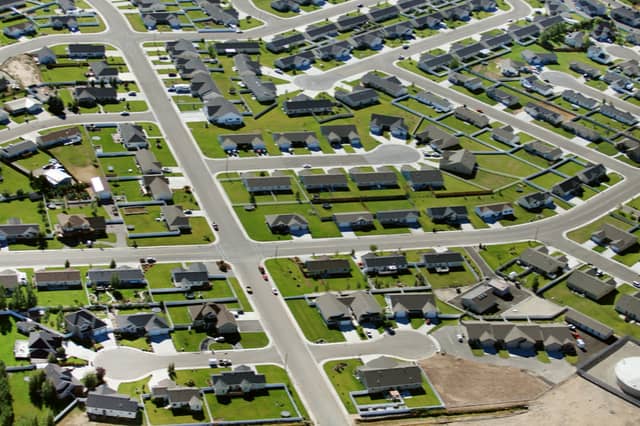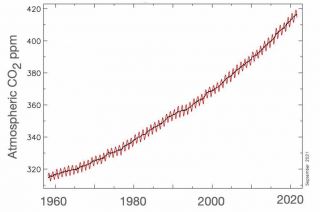
www.buildingsandcities.org/insights/commentaries/cop26-carbon-dependency.html
Unlock Carbon Dependency: Integrate Low-Carbon Development and Territorial Justice

By Stefan Siedentop (ILS - Research Institute for Regional and Urban Development & TU Dortmund University, DE)
Considerable institutional, technological and social lock-in inhibits the needed transition to a climate-friendly society. To overcome this, the socio-spatial effects of climate action must be on an equal basis with mitigation efficacy. Overcoming carbon lock-in in the built environment is much more than a technical issue; it will require the synergy of social, environmental and territorial justice.
The IPCC's Sixth Assessment Report, which was published in August 2021, sends a clear, unequivocal message: only a radical reduction of CO2 and other GHG emissions can prevent global warming of more than 1.5 or 2.0 oC (IPCC 2021). Because of past climate policy failures, the reduction pathway is now particularly steep. Achieving the 1.5 oC target requires climate neutrality by 2050 at the latest, which implies annual emissions reductions of approximately 7 to 8% (UNEP 2019). This need confronts policy-makers with unprecedented challenges.
In the fields of architecture, construction, and urban planning, research has described the pathways toward a low-carbon future for many years. Examples include urban intensification, decentralized energy systems, transit-oriented development or energy-efficient improvements of building stocks. However, there is disillusionment with regard to the implementation of such concepts. The decarbonization of urban systems is still more of a distant utopia than a tangible future. Against this background, it is no longer enough to ask what needs to be done to achieve climate neutrality. Even more important is the question of why we are not doing what we should be doing. In the coming years, politics and society will have to deal more systematically with the institutional, technological and social barriers to the effective implementation of climate protection policies.
In recent years, science has attempted to provide comprehensive answers to this question. One approach that has received much attention is 'carbon lock-in', which addresses a strongly path-dependent 'captivity' in fossil technologies and the corresponding infrastructures, institutions, behaviour patterns, and discourses (Unruh 2000; Seto et al. 2016; Buschmann & Oels 2019). Carbon lock-in explains the failure of or delay in the adoption of low-carbon technologies and behaviours by the entrenchment of tightly interwoven social norms, institutions (such as regulations and subsidies), and robust routines in the application of a carbon-based technology.
The much-debated phenomenon of urban sprawl can serve as a perfect example; suburban built environments are the result of countless location decisions that are undertaken by households and firms with the promise of permanently low energy costs made possible by enormous public infrastructure investments. Over time, 'pro-sprawl' political, market, and social factors have been reinforced, thereby making it difficult to move away from this structure and the lifestyles intertwined with it. Suburbia, as we know it today, implies a high dependence on motorized transport and high energy and infrastructure expenditures, all of which substantially reduces the political options for 'breaking out' of this "techno-institutional complex" (Unruh 2000).
Previous policies that have aimed to promote more climate-friendly urban development have also been relatively unsuccessful because they can be easily de-legitimized with respect to their assumed uneven social outcomes. In recent years, urban transformation agendas have repeatedly been confronted with accusations of leading to a disproportionate burden on low-income households. References have been made to processes of gentrification and displacement in upgraded urban neighbourhoods (Checker 2011), the disproportionate burden of renewable energy production on rural regions, and the disadvantage of the suburban and rural population due to higher energy costs. Frames such as 'jobs versus environment', 'urban against rural' or 'sustainable for whom?' have been quite successful in undermining broader political support for a climate-friendly transformation policy.
It was not until recently that CO2 avoidance costs were recognized as being unequally distributed both socially and spatially. A sort of double disadvantage has thus become discernible; i.e., lower-income segments of the population were and are disproportionately affected by the burdens of the fossil energy and transport industries as well as climate change effects (reference is here made to the discourse on "environmental justice" and "climate justice", see Farrell 2016 and Klinsky & Mavrogianni 2020). At the same time, they are again disproportionately affected in the phase of replacing fossils with regenerative technologies through mechanisms of the labour market, energy and transport markets (Evans & Phelan 2016).
Against this background, the evaluation of climate policies must equally consider both efficacy and the distributional effects found across the social stratification structure and along the urban-rural gradient. The societal costs of environmental change must be safeguarded and shared fairly. Here, the discourse on 'just transition' can be taken up (Mc Cauley & Heffron 2018; Evans & Phelan 2016; Farrell 2016).
This also has a spatial dimension, which is the central point of this essay. We need to consider more the socio-spatial effects of climate action in the design of policies and programs of action. What is needed are compensation mechanisms that avoid social hardship. Such mechanisms must be implemented at the micro level, for example, in tax, levy, labour market and social policies. However, place-based approaches are also needed to facilitate climate- and socially-compatible adaptation pathways in suburban and rural regions, as well as access to meaningful public participation. In short, breaking out of the carbon lock-in requires the synergy of social, environmental and territorial justice.
References
Buschmann, P., Oels, A. (2019). The overlooked role of discourse in breaking carbon lock-in: The case of the German energy transition. WIREs Climate Change, 10, 1-14. https://doi.org/10.1002/wcc.574
Checker, M. (2011). Wiped out by the "Greenwave": environmental gentrification and the paradoxical politics of urban sustainability. City & Society, 23, 210-229. https://doi.org/10.1111/j.1548-744X.2011.01063.x
Evans, G., Phelan, L. (2016). Transition to a post-carbon society: linking environmental justice and just transition discourses. Energy Policy, 99, 329-339. https://doi.org/10.1016/j.enpol.2016.05.003
Farrell, C. (2016). A just transition: Lessons learned from the environmental justice movement. Duke Forum for Law & Social Change, 4, 45-63. https://scholarship.law.duke.edu/dflsc/vol4/iss1/3
IPCC (2021). Summary for Policymakers. In: Climate Change 2021: The Physical Science Basis. Contribution of Working Group I to the Sixth Assessment Report of the Intergovernmental Panel on Climate Change. Cambridge University Press.
Klinsky, S., & Mavrogianni, A. (2020). Climate justice and the built environment. Buildings and Cities, 1(1), 412-428. https://doi.org/10.5334/bc.65
McCauley, D., Heffron, R. (2018). Just transition: Integrating climate, energy and environmental justice. Energy Policy, 119, 1-7. https://doi.org/10.1016/j.enpol.2018.04.014
Seto, K.C., Davis, S.J., Mitchell, R.B., Stokes, E.C., Unruh, G.C., Ürge-Vorsatz, D. (2016). Carbon lock-In: Types, causes, and policy implications. Annual Review of Environment and Resources, 41, 425-452. https://doi.org/10.1146/annurev-environ-110615-085934
UNEP. (2019). Emissions Gap Report 2019. Executive summary. Nairobi: United Nations Environment Programme.
Unruh, G.C. (2000). Understanding carbon lock-in. Energy Policy, 28, 817-830. https://doi.org/10.1016/S0301-4215(00)00070-7
Latest Peer-Reviewed Journal Content
Designing for pro-environmental behaviour change: the aspiration–reality gap
J Simpson & J Uttley
Lifetimes of demolished buildings in US and European cities
J Berglund-Brown, I Dobie, J Hewitt, C De Wolf & J Ochsendorf
Expanding the framework of urban living labs using grassroots methods
T Ahmed, I Delsante & L Migliavacca
Youth engagement in urban living labs: tools, methods and pedagogies
N Charalambous, C Panayi, C Mady, T Augustinčić & D Berc
Co-creating urban transformation: a stakeholder analysis for Germany’s heat transition
P Heger, C Bieber, M Hendawy & A Shooshtari
Placemaking living lab: creating resilient social and spatial infrastructures
M Dodd, N Madabhushi & R Lees
Church pipe organs: historical tuning records as indoor environmental evidence
B Bingley, A Knight & Y Xing
A framework for 1.5°C-aligned GHG budgets in architecture
G Betti, I Spaar, D Bachmann, A Jerosch-Herold, E Kühner, R Yang, K Avhad & S Sinning
Net zero retrofit of the building stock [editorial]
D Godoy-Shimizu & P Steadman
Co-learning in living labs: nurturing civic agency and resilience
A Belfield
The importance of multi-roles and code-switching in living labs
H Noller & A Tarik
Researchers’ shifting roles in living labs for knowledge co-production
C-C Dobre & G Faldi
Increasing civic resilience in urban living labs: city authorities’ roles
E Alatalo, M Laine & M Kyrönviita
Co-curation as civic practice in community engagement
Z Li, M Sunikka-Blank, R Purohit & F Samuel
Preserving buildings: emission reductions from circular economy strategies in Austria
N Alaux, V Kulmer, J Vogel & A Passer
Urban living labs: relationality between institutions and local circularity
P Palo, M Adelfio, J Lundin & E Brandão
Living labs: epistemic modelling, temporariness and land value
J Clossick, T Khonsari & U Steven
Co-creating interventions to prevent mosquito-borne disease transmission in hospitals
O Sloan Wood, E Lupenza, D M Agnello, J B Knudsen, M Msellem, K L Schiøler & F Saleh
Circularity at the neighbourhood scale: co-creative living lab lessons
J Honsa, A Versele, T Van de Kerckhove & C Piccardo
Positive energy districts and energy communities: how living labs create value
E Malakhatka, O Shafqat, A Sandoff & L Thuvander
Built environment governance and professionalism: the end of laissez-faire (again)
S Foxell
Co-creating justice in housing energy transitions through energy living labs
D Ricci, C Leiwakabessy, S van Wieringen, P de Koning & T Konstantinou
HVAC characterisation of existing Canadian buildings for decarbonisation retrofit identification
J Adebisi & J J McArthur
Simulation and the building performance gap [editorial]
M Donn
Developing criteria for effective building-sector commitments in nationally determined contributions
P Graham, K McFarlane & M Taheri
Join Our Community

The most important part of any journal is our people – readers, authors, reviewers, editorial board members and editors. You are cordially invited to join our community by joining our mailing list. We send out occasional emails about the journal – calls for papers, special issues, events and more.
We will not share your email with third parties. Read more



Latest Commentaries
COP30 Report
Matti Kuittinen (Aalto University) reflects on his experience of attending the 2025 UN Conference of the Parties in Belém, Brazil. The roadmaps and commitments failed to deliver the objectives of the 2025 Paris Agreement. However, 2 countries - Japan and Senegal - announced they are creating roadmaps to decarbonise their buildings. An international group of government ministers put housing on the agenda - specifying the need for reduced carbon and energy use along with affordability, quality and climate resilience.
Building-Related Research: New Context, New Challenges
Raymond J. Cole (University of British Columbia) reflects on the key challenges raised in the 34 commissioned essays for Buildings & Cities 5th anniversary. Not only are key research issues identified, but the consequences of changing contexts for conducting research and tailoring its influence on society are highlighted as key areas of action.